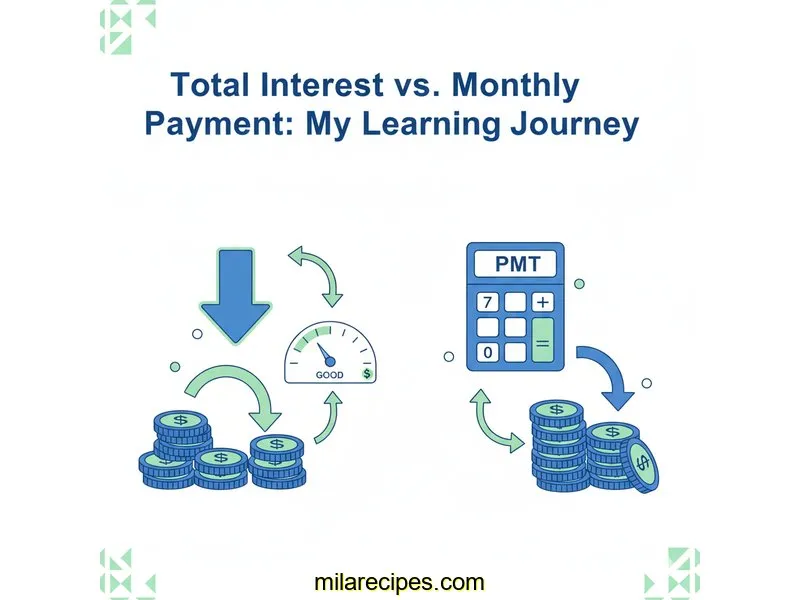
Auto Loan Calculator
Calculate payments over the life of your Loan
Home Blog Privacy Terms About Contact
Calculate payments over the life of your Loan
Home Blog Privacy Terms About ContactPublished on October 26, 2025

It all started with a simple question that I couldn't shake. I was looking at some hypothetical loan scenarios online, just for fun, trying to get a better handle on how these things work. I noticed something that seemed counterintuitive: a loan with a lower monthly payment could actually cost more. How could that be? If you're paying less each month, shouldn't the total be less too?
This little puzzle sent me down a rabbit hole. I wasn't trying to make a financial decision or find the "best" loan. My goal was purely educational. I just wanted to understand the mechanics behind the numbers. Why would paying, say, $340 a month end up being more expensive than paying $411 a month? The numbers just didn't seem to align in my head, and I felt like I was missing a critical piece of the puzzle.
My first attempts involved plugging numbers into a basic online calculator. I put in a loan amount, an interest rate, and a term, and it spat out a monthly payment. Great. But when I changed the term from four years to five years, the payment went down, and I thought, "Aha, that's the cheaper option!" I was completely focused on that single number, the monthly payment, because it felt the most immediate and tangible. I didn't yet realize that it was only telling a small part of a much larger story.
This article is my journey of untangling that confusion. It's about how I learned to look beyond the monthly payment and understand the deeper relationship between time, interest, and total cost. This is about understanding how calculations work, not financial advice. My hope is that by sharing my process, I can help demystify some of this math for others who are just as curious as I was.
My main point of confusion was rooted in a specific comparison I was running for my own educational benefit. I decided to use a hypothetical loan amount of $16,850 at an interest rate of 7.8%. My goal was to see how changing the loan term affected the numbers. I was curious about the mathematical difference between a four-year term and a five-year term.
I popped the numbers into an online loan calculator. First, I set the term to 48 months (4 years). The calculator returned a monthly payment of around $411.37. Then, I changed only one variable: the term. I increased it to 60 months (5 years). The new monthly payment was $339.75. My initial reaction was exactly what you might expect: "Wow, the five-year option is over $70 cheaper per month! That seems much more manageable."
For a while, that’s where my analysis stopped. I was stuck on the idea that a lower monthly payment meant a "cheaper" loan. It just seemed logical. But a nagging feeling told me I was missing something important. How could stretching out the payments result in a better deal? It felt like getting a discount just for taking longer to pay, which didn't make sense. The numbers felt disconnected from the reality of how interest works.
My frustration grew when I tried to manually calculate the total cost. For the 48-month scenario, I multiplied $411.37 by 48 and got $19,745.76. For the 60-month scenario, I multiplied $339.75 by 60 and got $20,385. That's when it hit me. The "cheaper" monthly payment resulted in a total cost that was over $600 higher. I had been so focused on the monthly cash flow that I completely ignored the total amount paid over the life of the loan. I was comparing apples and oranges without even realizing it.
This was the moment I understood that the monthly payment and the total cost tell two very different stories. One tells you about affordability right now, and the other tells you about the actual cost over time. My mistake was assuming they were telling the same story. I knew then that I had to dig deeper and understand why that extra year added so much to the total interest.
The real breakthrough came when I explored a more advanced loan calculator. This one had more fields, including a summary box that broke down the results. And in that box was a line item that I had previously ignored: "Total Interest Paid." This, I soon realized, was the key to unlocking the entire puzzle.
Instead of just looking at the monthly payment, I started focusing on this new number. I ran my original scenario again: $16,850 at 7.8%. When I set the term to 48 months, the calculator showed the monthly payment ($411.37) but also calculated the total interest: $2,895.76. Then, I switched the term to 60 months. The monthly payment dropped to $339.75, but the total interest jumped to $3,535.00.
Seeing those two interest figures side-by-side was my "aha" moment. The difference wasn't just a few dollars; it was $639.24. That was the hidden cost of the lower monthly payment, the price of that extra year of financing. The calculator was showing me that while the monthly burden was lower, the longer timeframe gave the interest more time to accumulate on the outstanding balance. It was a trade-off I hadn't been able to see before.
My learning process became a series of small, connected discoveries. It wasn't just one thing, but a chain reaction of understanding. Once I saw the "Total Interest Paid" field, everything else started to click into place.
I started to understand that every loan payment is split into two parts: principal (the money you actually borrowed) and interest (the cost of borrowing it). With a longer loan term, even though your payment is smaller, a larger portion of your early payments goes toward interest. You're chipping away at the principal much more slowly, which means the balance stays higher for longer, generating more interest over time.
The online calculator I used also had an amortization schedule feature. Clicking on it was another eye-opener. I could see, month-by-month, how my payment was being divided. For the 60-month loan, I could literally see how little principal was being paid off in the first year compared to the 48-month loan. That visual representation made the abstract concept of amortization tangible.
The extra year wasn't "free." The $71.62 I was saving each month on the 5-year term was costing me $639.24 in the long run. Understanding this trade-off was purely about the math. It wasn't about which option was "better," but about what the numbers were actually saying.
To make sure I really understood, I ran a completely different scenario. I imagined a loan for $12,500 at a lower rate of 6.5%. First, I calculated it for 36 months (3 years): the payment was about $382.72, and the total interest was $1,277.92. Then, I changed it to 48 months (4 years): the payment dropped to $295.95, but the total interest rose to $1,705.60. The pattern held. A lower monthly payment, achieved through a longer term, resulted in a higher total interest cost. I finally felt like I had a solid grasp of the mechanics.
This journey wasn't about becoming a financial expert. It was about achieving a level of comfort and understanding with the numbers that shape these financial tools. It was about building calculation literacy for myself. Here are the biggest lessons I took away about the math itself:
During my learning process, I had a lot of questions. Here are a few I managed to answer for myself, focusing strictly on how the calculations work.
The calculation for a loan payment (the amortization formula) is complex, but the principle is simple. With a longer term, you are making more payments. While each payment is smaller, the interest is calculated on the remaining balance each month. A slower paydown of the principal means the balance stays higher for longer, so you end up paying interest on a larger amount of money over a greater number of months, leading to a higher total interest cost.
That formula is for simple interest, but most personal loans use compound interest, which is calculated on a declining balance. Each month, part of your payment reduces the principal. The next month's interest is calculated on this new, slightly lower balance. This is why the interest portion of your payment decreases over time. A simple interest calculation would be wildly inaccurate for this type of loan.
From my learning journey, the most illuminating field for understanding the absolute cost is "Total Interest Paid." While the monthly payment is essential for budgeting and APR is crucial for comparing offers (as it includes fees), the total interest figure shows you, in plain dollars, the cumulative cost of borrowing the money over the entire term.
An amortization schedule is a table that shows each payment over the life of the loan. For every payment, it breaks down how much goes toward principal and how much goes toward interest. It also shows the remaining balance after each payment. It's an incredible educational tool for visualizing how slowly the principal is paid down at the start and how that process accelerates toward the end.

My biggest takeaway from this entire experience is that the story of a loan is told by several numbers, not just one. My initial focus on the monthly payment was like reading only one page of a book and thinking I understood the plot. It was only when I learned to look at the loan term, the total payments, and especially the total interest paid that the full narrative became clear.
I feel much more confident in my ability to use financial calculators not just as tools for answers, but as tools for understanding. Playing with the numbers, asking "what if," and seeing the direct consequences on the calculations was an empowering process. It transformed intimidating financial math into a logical system of trade-offs.
I encourage anyone who feels overwhelmed by these topics to simply get curious. Pick one thing you don't understand, find a good calculator, and start experimenting. You might be surprised at how much you can learn just by changing the variables and watching how the numbers dance. It's a journey worth taking.
This article is about understanding calculations and using tools. For financial decisions, always consult a qualified financial professional.
Disclaimer: This article documents my personal journey learning about loan calculations and how to use financial calculators. This is educational content about understanding math and using tools—not financial advice. Actual loan terms, rates, and costs vary based on individual circumstances, creditworthiness, and lender policies. Calculator results are estimates for educational purposes. Always verify calculations with your lender and consult a qualified financial advisor before making any financial decisions.
